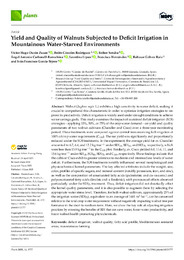Por favor, use este identificador para citar o enlazar este ítem:
https://hdl.handle.net/11000/37102Registro completo de metadatos
| Campo DC | Valor | Lengua/Idioma |
|---|---|---|
| dc.contributor.author | DURAN ZUAZO, VICTOR HUGO | - |
| dc.contributor.author | Cárceles Rodríguez, Belén | - |
| dc.contributor.author | Sendra, Esther | - |
| dc.contributor.author | Carbonell-Barrachina, Ángel A. | - |
| dc.contributor.author | Lipan, Leontina | - |
| dc.contributor.author | Hernández García, Francisca | - |
| dc.contributor.author | Gálvez Ruiz, Baltasar | - |
| dc.contributor.author | García-Tejero, Iván Francisco | - |
| dc.contributor.other | Departamentos de la UMH::Producción Vegetal y Microbiología | es_ES |
| dc.date.accessioned | 2025-07-31T10:23:48Z | - |
| dc.date.available | 2025-07-31T10:23:48Z | - |
| dc.date.created | 2025-06 | - |
| dc.identifier.citation | Plants 2025, 14(12), 1777 | es_ES |
| dc.identifier.uri | https://hdl.handle.net/11000/37102 | - |
| dc.description.abstract | Walnut (Juglans regia L.) exhibits a high sensitivity to water deficit, making it crucial to comprehend this characteristic in order to optimize irrigation strategies to improve its productivity. Deficit irrigation is widely used under drought conditions to achieve water savings goals. This study examines the impact of sustained deficit irrigation (SDI) strategies—applying 33%, 50%, or 75% of the crop water demand—on yield and quality parameters of two walnut cultivars (Chandler and Cisco) over a three-year monitoring period. These treatments were compared against control trees receiving full irrigation at 100% of crop water requirements (C100). The nut yield was significantly and proportionally reduced under the SDI treatments. In the experiment, the average yield for cv. Chandler amounted to 6.7, 6.4, and 12.2 kg tree−1 under SDI33, SDI50, and SDI75, respectively, which were less than 13.9 kg tree−1 in the C100 plot. Similarly, cv. Cisco yielded 8.0, 11.6, 11, and 15.6 kg tree−1 under SDI33, SDI50, SDI75, and C100, respectively. These findings indicate that the cultivar Cisco exhibits greater tolerance to moderate and intermediate levels of water deficit. Furthermore, the SDI treatments notably influenced several morphological and physicochemical kernel parameters. The key affected attributes include the weight, size, color, profiles of specific sugars, and mineral content (notably potassium, iron, and zinc), as well as the composition of unsaturated fatty acids (palmitoleic and cis-vaccenic) and polyunsaturated fatty acids (linoleic and α-linolenic), with pronounced effects observed particularly under the SDI75 treatment. Thus, deficit irrigation did not drastically affect the kernel quality parameters, and it is also possible to augment them by selecting the appropriate water stress level. Therefore, for both walnut cultivars, approximately 25% of the irrigation water (SDI75), equivalent to an average of 1681 m3 ha−1, can be conserved relative to the total crop water requirement without negatively impacting walnut tree performance in the short to medium term. Here, we show the key role of adjusting irrigation practices by stressing the benefits of SDI that can save water, foster water productivity, and boost walnut health-promoting phytochemicals. | es_ES |
| dc.format | application/pdf | es_ES |
| dc.format.extent | 28 | es_ES |
| dc.language.iso | eng | es_ES |
| dc.publisher | MDPI | es_ES |
| dc.rights | info:eu-repo/semantics/openAccess | es_ES |
| dc.rights.uri | http://creativecommons.org/licenses/by-nc-nd/4.0/ | * |
| dc.subject | deficit irrigation | es_ES |
| dc.subject | walnut quality | es_ES |
| dc.subject | fatty acid profile | es_ES |
| dc.subject | Mediterranean semiarid areas | es_ES |
| dc.subject | mountainous farming | es_ES |
| dc.subject.other | CDU::6 - Ciencias aplicadas::66 - Ingeniería, tecnología e industria química. Metalurgia::663/664 - Alimentos y nutrición. Enología. Aceites. Grasas | es_ES |
| dc.title | Yield and quality of walnuts subjected to deficit irrigation in mountainous water-starved environments | es_ES |
| dc.type | info:eu-repo/semantics/article | es_ES |
| dc.relation.publisherversion | https://doi.org/10.3390/plants14121777 | es_ES |

Ver/Abrir:
plants-14-01777.pdf
1,37 MB
Adobe PDF
Compartir:
 La licencia se describe como: Atribución-NonComercial-NoDerivada 4.0 Internacional.
La licencia se describe como: Atribución-NonComercial-NoDerivada 4.0 Internacional.
.png)